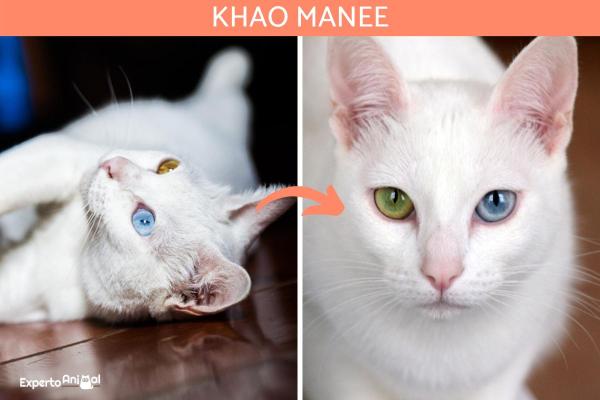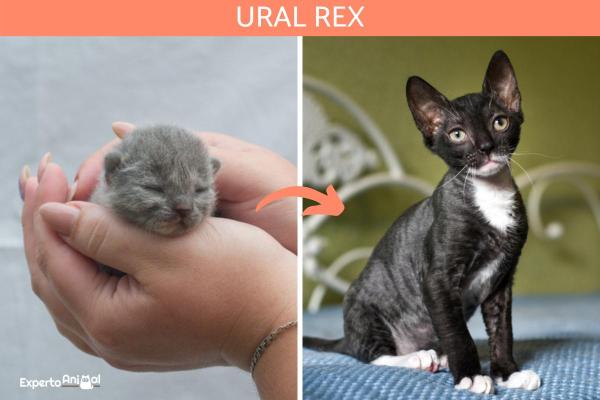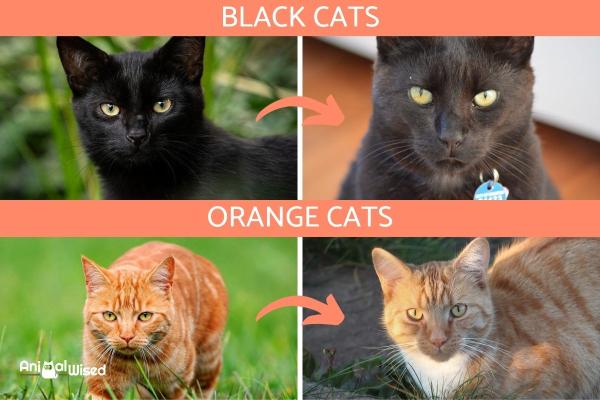My Cat's Fur Is Changing Color



See files for Cats
What a cat will look like physically is, for the most part, dictated by their genetics. The genes carried by their parents will determine what is their eventual body shape, coat type and color. Although cats will look different when compared to being a kitten with being an adult cat, it doesn't mean they will change completely. Some animals will look markedly different when they are an adult compared to when they were young, but cats do not generally fall into this category. For this reason, we should know that there are various situations which might mean a cat's fur changes color, many of which can be worrying.
At AnimalWised, we look at what happens when your cat's fur is changing color. We ask whether this is normal and understand what might be causing the phenomenon.
Can the color of cats change?
The color of a cat's hair is determined by their genetics. This is why certain breeds may be of only one coat color or pattern, while others can be more varied. This is due to the limitations of their gene pool. Genetic will also determine if the cat's coat is long, short, wavy, thin or abundant. Shedding, brushing, grooming and other factors may change their coat in some way, but these genetics will not.
If your cat's fur is changing color, it can be due to various causes. These can be both pathological disease or environmental changes. They include:
- Age
- Stress
- Sun
- Bad nutrition
- Intestinal disease
- Renal disease
- Liver disease
- Endocrine disease
- Infectious disease
- Skin disease
Does a kittens hair change color as they develop?
Although there is some breed variation, cats generally do not change the color of their fur as they grow. This is unlike a cat's eyes. All kittens are born with blue eyes. It is not until they are a little older than color pigmentation in the eye develops and we can see the final eye color.
As a cat develops into an adult, their coat color will remain the same. However, the tonality of the fur can change. Usually the tone will intensify, meaning it will be bolder and richer as an adult.
The few breeds where fur color does change as they age include:
- Himalayan
- Siamese
- Khao Manee
- Ural Rex
Himalayan and Siamese cats
All cats carry a gene which enables them to produce melanin, with the exception of albino cats (although they may be able to produce a small amount). This is the pigment which will determine the color of the cat's fur. Siamese and Himalayan types cats have a color-point coat pattern where their extremities are darker than their main body.
The reason for this is because these breeds have an enzyme involved in melanin production which only activates at lower temperatures. As a cat's body temperature is lower at the extremities, it causes the fur color to be darker in these places. This is actually a type of partial albinism[1].
The ambient temperature can affect the color of a color-point cat's fur. For these cats, when the temperatures rise in the summer, the enzyme doesn't act as much and the color of their fur can lighten. Conversely, when the temperatures drop, the fur tends to be a little darker. However, the change won't necessarily be very dramatic and we may not notice it as much if we keep our home at a constant temperature.
Siamese cats can also develop something known as periocular leukotrichia. This is when hairs around the eyes turn white due to depigmentation. This change can occur when the feline is poorly fed, if they are pregnant, when kittens grow fast or if they have a systemic disease. For this reason, they will need to be taken to the veterinarian for diagnosis.

Khao Manee
When they are born, Khao manee cats have a dark spot on their head. However, after a few months, the this white spot of fur will disappear and the adult specimen will have a completely white coat.

Ural Rex
Another example of a cat with fur which changes color is the Ural Rex. These cats are born with grayish colored fur. After their first molt (when the cat sheds hair), their final color will present. At around 3-4 months, they will also begin to grow the wavy hair which characterizes the breed. However, it is not until 2 years of age that the individuals will acquire the phenotype of an adult Ural Rex.

Senior cats
The natural aging process means a luck cat can live over ten years of age, but after this point most will start to be considered senior cats. When this happens, their fur can acquire a slight change in color and tone. They may even develop gray hairs. The coat colors where these signs of aging in cats us most noticeable are in black and orange cats. A black cat's fur will start to acquire a grayish hue and orange cats can start to yellow a little.

Change in your cat's fur due to stress
Cats are especially sensitive to stress. Even relatively small environmental changes can alter their behavior and we can see them develop signs of stress.
An episode of acute stress can cause something known as telogen effluvium. This is a process by which more hair follicles than normal go from the anagen phase of growth to the telogen phase (when the hair sheds). However, it can also affect a change in the color of the cat's fur. This color change can vary, but most often it tends to become paler or even appear gray.
Change in your cat's fur color due to sunlight
The sun's rays can affect the external appearance of our cat's hair, in particular its coloration. It can also affect the structure as sunlight might dry out the hair. Being in direct sunlight is something which cats love to do, lying in it for hours like a sunbather. This causes their fur to wash out and decrease in tonality. Similar to age, black cats can turn grayish and orange cats turn yellowish.
A cat with outdoor access may have more opportunity to be in the sun, but even indoor cats will search out sunlight. When the sun's rays pour through the window, they will lay where it lands. We need to be careful with this as direct sunlight encourages kin cancers such as a squamous cell carcinoma.
Change in your cat's fur color due to poor nutrition
Cats are carnivores, they need to consume animal tissue daily as it offers the necessary protein they need to survive. All the essential nutrients they require can only be obtained from this source. Two examples include the essential amino acids phenylalanine and tyrosine. These amino acids are responsible for synthesizing melanin, the pigment that gives hair a dark color.
When a cat eats a diet deficient animal protein, it develops nutritional deficiencies. Among them, phenylalanine or tyrosine deficiency which can cause the cat's fur to change color. This is often observed in black cats who have hair which turns reddish due to the lack of nutrients and the consequent reduction of melanin. This reddish-orange color change in black cats can be seen in other nutritional deficiencies, such as zinc and copper deficiency.

Change in your cat's fur color due to illness
When a well-fed dark cat that eats abundant animal protein begins to turn orange, problems at the level of intestinal absorption which suggest a lack of the amino acid tyrosine or phenylalanine must be ruled out. These problems can be due to intestinal malabsorption. These can be due to intestinal tumors, inflammatory bowel disease and infectious enteritis.
Disorders in the secretion and production of bile acids from the liver or enzymes in the pancreas also hinder digestion and absorption of nutrients. Sometimes these processes, together with an inflammatory bowel disease, can appear together in the cat, resulting in something called feline triaditis.
Other diseases that cause alterations in the color of the hair, appearance or condition of the skin of our cats include the following:
- Kidney disease: in chronic kidney failure the hair of our cats tends to become dull, paler, drier and lifeless.
- Liver disease: the liver is key in the transformation of the essential amino acid phenylalanine into tyrosine. Due to this, a liver disease such as lipidosis, hepatitis or a hepatic tumor can affect the functionality of this process and the black feline will turn orange.
- Jaundice: the yellow coloration of the skin and mucous membranes of our feline can be due to a liver problem or hemolytic anemia. It can sometimes be reflected in the hair, especially if the feline is light, turning yellowish to a certain extent.
- Endocrine diseases: such as hyperadrenocorticism (Cushing's syndrome) or hypothyroidism , less frequent in cats than in dogs, can alter the skin and hair of our cat. In these cases, the skin darkens, they lose hair (alopecia) or it becomes very brittle.
- Atopic dermatitis: this allergic disease makes our cat's skin red and itchy. Excessive grooming can cause alopecia. It can also be as a result of ringworm or external parasites.
- Vitiligo: consists of a sudden or progressive change in the pigmentation of the skin and hair of small cats. In this case, the hair is depigmented, turning completely white. It is very rare, affecting less than 2 cats per 1000 and can be caused by the presence of antimelanocyte antibodies, which target melanocytes and inhibit melanin production and the consequent darkening of the hair. It makes your cat's hair color almost entirely white.
Many of these diseases can lead to a cat's hair not only changing color, but to fall out. For more information, check out our AnimalWised video below:

If you want to read similar articles to My Cat's Fur Is Changing Color, we recommend you visit our Facts about the animal kingdom category.
1. Imes, D. L., Geary, L. A., Grahn, R. A., & Lyons, L. A. (2006). Albinism in the domestic cat (Felis catus) is associated with a tyrosinase (TYR) mutation. Animal Genetics, 37(2), 175-178.
https://www.ncbi.nlm.nih.gov/pmc/articles/PMC1464423/










